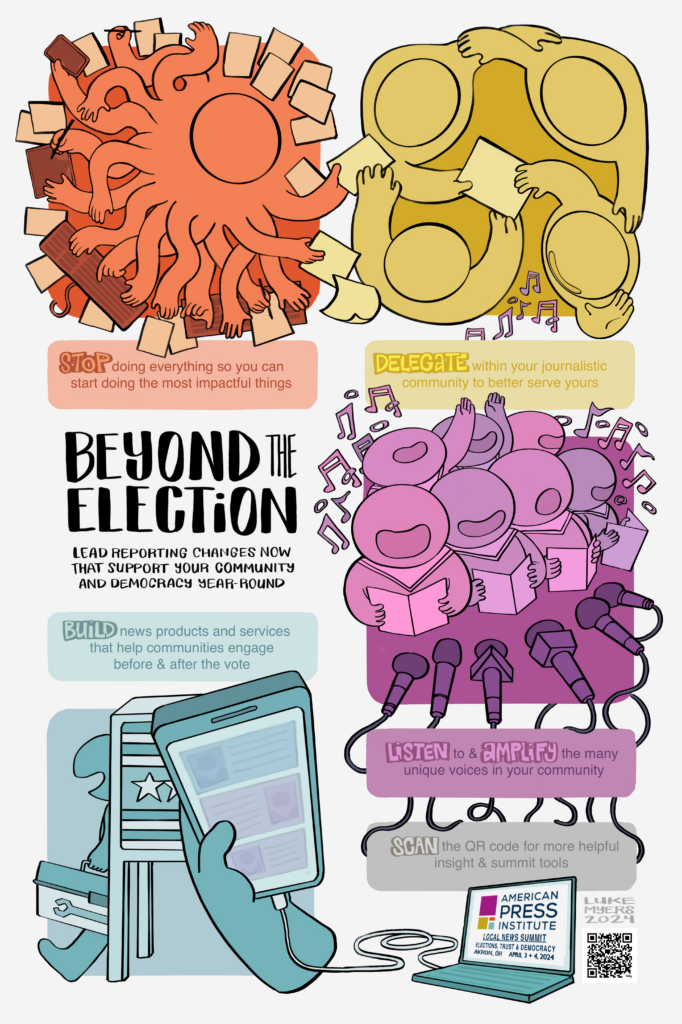The American Press Institute started publishing resources in November 2023 to help local media improve local election coverage for 2024.
We wanted to start empowering news leaders early on to consider how they shape and share the news and information their communities would use to make decisions up and down the ballot. And, importantly, we pushed newsrooms even then to think about how their election coverage might build toward deeper relationships after this November’s results are final.
“If you’re taking the time to lay a comprehensive plan for the lead-up and coverage of results,” we wrote, “what follows all your hard work?” We went on: “Do you have an off-ramp for all the attention headed your way, and the investment of your time?” Where do you point audiences next?
This sentiment has been at the heart of many API resources and programs over the past 11 months. With November fast-approaching, we are re-upping both Election Day and post-election resources that news leaders may want to use:
- Join our AP + API webinar: Pulling back the curtain on what happens on election night, taking place Thursday, September 26, from 1 – 2 p.m. EDT. A capstone to our 7-month series, this is a chance to think about how races are called and how you might plan explanatory journalism around election day. It complements this month’s Need to Know newsletter takeover by The Associated Press (sign up for more insights on Monday).
- Discuss: Preparing for Election Day and the immediate period after. Use this discussion guide in our Critical Conversation series to plan with colleagues.
- Prepare: Protect your physical safety, your online safety and know your legal rights. This collaboration with International Women’s Media Foundation and with insight from the Reporters’ Committee can help.
- Prepare: Make contact with local election officials and use these other tips especially helpful for reporters new to covering elections, a collaboration with The Elections Group.
- Discuss: Your post-election coverage. Use this discussion guide to train your eyes toward post-election stories and civic engagement beyond the ballot box.
- Design: Build products and services that help residents post-election using the Strategyzer Value Proposition Canvas. This tool can help examine how your election coverage flows into other civically-oriented coverage.
- Steward: Prioritize your workload by eliminating or delegating tasks that distract from your goals. These tools and frameworks can help you evaluate how you’re working.
- Schedule: We have a trove of retrospective meeting questions to inspire discussion once you are able to slow down.

Looking for more ideas and tactics? Get inspired with 4 ideas on election engagement that can lead to longer-term relationships, a collection of essays from participants in our April 2024 API Local News Summit on Elections, Trust and Democracy. This summit gathered more than 60 leaders focused on building relationships that go beyond elections:
- How to use voting districts to kickstart community listening
- Social media tactics for your voter guides that can help explain civic engagement year-round
- How a voter guide can jumpstart deeper engagement
- Strengthen neighborhood belonging with your local election coverage
Table Stakes alumni and programming also offer inspiration:
- How to use Reddit understand election information needs
- How a “Make it Make Sense” newsletter and other products serve audiences
- Use events to supercharge your election coverage
Or, browse projects from the 21 grantees in our Election Coverage and Community Listening Fund and 31 grantees in our newly-announced Election Engagement Experiment Fund alongside the Knight Election Hub.
As we move from pre-election to post, we also invite you to follow these collaborations with local influencers and trusted messengers to share nonpartisan journalism before and after the elections.
We’re rooting for your work in the weeks to come and for how it builds to something robust and sustained.
You might also be interested in:
As the American Press Institute marks 80 years, we’ll honor our legacy by continuing to respond to the evolving needs of news leaders. Our upcoming API Local News Summits will explore three critical places where democracy and sustainability intersect.
Reaching younger audiences has long been a challenge for media organizations. As platforms evolve, trust in news shifts and news avoidance grows, it can feel especially difficult to connect with and serve multigenerational audiences in an authentic and sustainable way. How can news leaders do their part to represent and include community perspectives from members of different age groups?
For us, we knew one of our biggest hurdles to success would be challenging the assumptions, both spoken and unspoken, we held for others. Here’s what we’ve learned over the past three years of gathering multigenerational problem-solvers.



